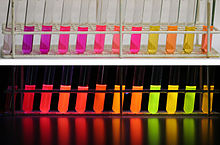- Nile red
-
Nile red 
 9-diethylamino-5-benzo[α]phenoxazinoneOther namesNile red, Nile blue oxazone
9-diethylamino-5-benzo[α]phenoxazinoneOther namesNile red, Nile blue oxazoneIdentifiers CAS number 7385-67-3 
PubChem 65182 ChemSpider 58681 
ChEBI CHEBI:52169 
ChEMBL CHEMBL144472 
Jmol-3D images Image 1 - CCN(CC)c1ccc2c(c1)oc-3cc(=O)c4ccccc4c3n2
Properties Molecular formula C20H18N2O2 Molar mass 318.369 g/mol  (verify) (what is:
(verify) (what is:  /
/ ?)
?)
Except where noted otherwise, data are given for materials in their standard state (at 25 °C, 100 kPa)Infobox references  Nile red under visible and ultraviolet (366 nm) light in different solvents
Nile red under visible and ultraviolet (366 nm) light in different solvents
From left to right: 1. water, 2. methanol, 3. ethanol, 4. acetonitrile, 5. dimethylformamide, 6. acetone, 7. ethyl acetate, 8. dichloromethane, 9. n-hexane, 10. methyl-tert-butylether, 11. cyclohexane, 12. toluene.Nile red (also known as Nile blue oxazone) is a lipophilic stain. It is produced by boiling a solution of Nile blue with sulfuric acid.[1] As can be seen from the structural formulae, this process replaces an amino group with a carbonyl group. Nile red stains intracellular lipid droplets red. In most polar solvents Nile Red will not fluoresce, however when in a lipid-rich environment can be intensely fluorescent, with varying colours from deep red to strong yellow-gold emission. It excites at 485 nm, and emits at 525 nm (552/636 nm in methanol), the fluorescence of the dye is heavily dependent on the solvent used.
Since the reaction to generate Nile red does not usually completely exhaust the supply of Nile blue, additional separation steps are required if pure Nile red is needed.
References
- ^ SD Fowler and P Greenspan (1985). "Application of Nile red, a fluorescent hydrophobic probe, for the detection of neutral lipid deposits in tissue sections: comparison with oil red O". Journal of Histochemistry and Cytochemistry 33 (8): 833–836.
Categories:- Fluorescent dyes
- Oxazin dyes
- Vital stains
- Naphthobenzoxazines
Wikimedia Foundation. 2010.
